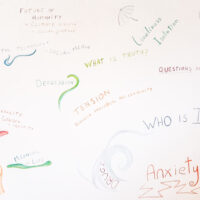The other day, we were looking at photos from our vacation, and one had slipped in of grandma and grandpa back home. Meaning to say “people who stayed home,” our eleven-year-old, in a little slip of the tongue, referred to them as “people who stayed hidden,” like a secret. (In German, Daheimgebliebenen and Geheimgebliebenen.) It’s a magical word that we’ve been tasting, twisting, and turning ever since, wondering: who are the secret ones anyway? And what do they do?
After a lecture or seminar, some of the audience come up to the lectern with a question, a thank you, or their sympathy. The lecturers will remember them but hardly recall the many others who quietly leave the hall with a friendly nod of the head from a distance. Nevertheless, how often does a new world grow out of a thought, taken from the evening, in just such an unknown, silent listener? “The silence ripens,” Rudolf Steiner mused. Yes, often it happens in “secret”—the currents of anthroposophy may be determined less in branch meetings and conferences than in reading at the doctor’s office, in the conversation on the train, or in the remark overheard in the corridor. Presumably, it is no different in the soul: there, too, the spiritual thought that remains tucked away inside, secret to the rest of us, bears the real fruit. Perhaps that is why early anthroposophy is a “secret science” (Geheimwissenschaft), because it is about these quiet, secret pathways—the ways to those who stayed hidden.
(Translator note: Geheimwissenschaft is sometimes translated as “occult science”, and continuing this lovely play of words, “occult” can also mean “hidden”.)
Translation Laura Liska
Title image Goetheanum cantilever chair Thonet S33, Photo: Johannes Kronenberg





